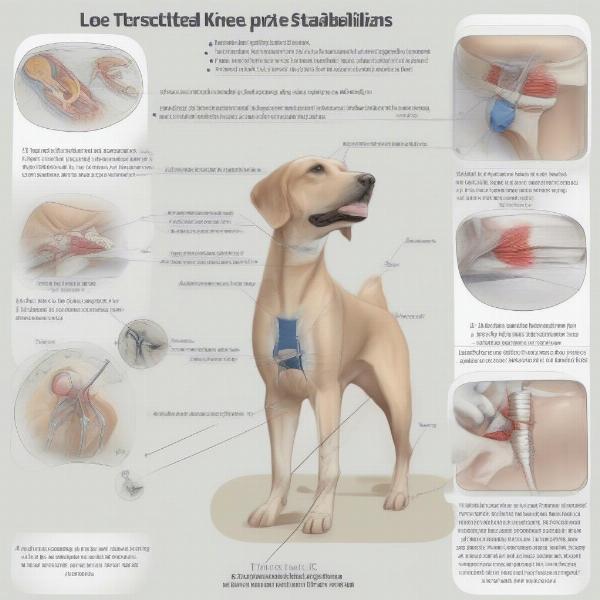Knee surgery in dogs is becoming increasingly common, offering a chance for improved mobility and pain relief. This guide explores the various aspects of canine knee surgery, from diagnosis to recovery, providing valuable insights for pet owners considering this option for their furry friends. Understanding the procedure, potential risks, and post-operative care is crucial for making informed decisions and ensuring a smooth recovery process.
Understanding Canine Knee Problems
Just like humans, dogs can suffer from a variety of knee issues. One of the most common is a cranial cruciate ligament (CCL) rupture, equivalent to an ACL tear in humans. This ligament stabilizes the knee joint, and a tear can cause pain, instability, and lameness. Other knee problems include luxating patella (slipping kneecap), meniscal tears, and arthritis. Accurate diagnosis is essential for determining the appropriate course of treatment, which may include surgery.
Common Signs of Knee Problems in Dogs
Recognizing the signs of knee problems is crucial for early intervention. These can include limping, stiffness, difficulty rising or climbing stairs, swelling around the knee joint, and a clicking or popping sound during movement. If your dog exhibits any of these symptoms, consult a veterinarian for a thorough examination.
Types of Knee Surgery for Dogs
Several surgical techniques are available to address canine knee problems. The most common for CCL ruptures include:
- Tibial Plateau Leveling Osteotomy (TPLO): This procedure involves reshaping the tibia (shinbone) to change the angle of the tibial plateau, stabilizing the knee joint.
- Tibial Tuberosity Advancement (TTA): This technique involves advancing the tibial tuberosity, altering the forces acting on the CCL and stabilizing the knee.
- Lateral Suture Stabilization: This method involves placing sutures outside the joint to mimic the function of the CCL. This is generally considered less effective for larger dogs.
 Types of Dog Knee Surgery
Types of Dog Knee Surgery
Choosing the Right Surgical Procedure
The best surgical option for your dog depends on factors such as their size, breed, age, activity level, and the severity of the knee injury. Your veterinarian will discuss the pros and cons of each procedure and recommend the most suitable approach for your dog’s specific needs.
Post-Operative Care and Recovery
Post-operative care is vital for a successful recovery after knee surgery in dogs. Pain management is paramount, and your veterinarian will prescribe appropriate medications. Restricted activity is crucial during the initial healing phase, usually involving crate rest and limited leash walks. Physical therapy, including specific exercises, can help restore strength and range of motion. The recovery period typically takes several months, and adherence to your veterinarian’s instructions is essential for optimal healing.
Cost of Knee Surgery for Dogs
The cost of knee surgery for dogs can vary depending on the type of procedure, the veterinarian’s fees, and the geographic location. It’s important to discuss the costs with your veterinarian beforehand and explore pet insurance options to help manage expenses.
Conclusion
Knee surgery can significantly improve the quality of life for dogs suffering from debilitating knee conditions. By understanding the different surgical options, post-operative care requirements, and potential costs, pet owners can make informed decisions and support their furry companions on their journey to recovery. Early diagnosis and intervention are key to achieving the best possible outcomes. Remember to consult your veterinarian for personalized advice and guidance tailored to your dog’s individual needs.
FAQ
- How long does it take for a dog to recover from knee surgery? Recovery typically takes several months, with full recovery expected within 6-8 months.
- What are the signs of a CCL tear in dogs? Common signs include limping, stiffness, difficulty rising, swelling, and clicking sounds in the knee.
- Is knee surgery always necessary for dogs with CCL tears? While surgery is often recommended, conservative management may be considered for some dogs, especially smaller breeds.
- What is the success rate of knee surgery in dogs? Success rates vary depending on the procedure and individual dog, but are generally high, resulting in significant improvement in mobility and pain relief.
- What are the potential complications of knee surgery in dogs? Potential complications, though rare, can include infection, implant failure, and nerve damage.
- How can I help my dog during recovery from knee surgery? Follow your veterinarian’s instructions regarding pain management, restricted activity, and physical therapy.
- Is pet insurance recommended for knee surgery? Pet insurance can help cover the costs of knee surgery and is often recommended for pet owners.
Related Articles
ILM Dog is your trusted resource for expert advice and information on all aspects of dog care, from breed selection and health to training and nutrition. We offer a range of resources, including articles, guides, and product recommendations, to help you provide the best possible care for your furry companion. For personalized guidance and support, contact us via email at [email protected] or call us at +44 20-3965-8624. ILM Dog is dedicated to helping you navigate the world of dog ownership with confidence and provide your canine friend with a happy, healthy life.